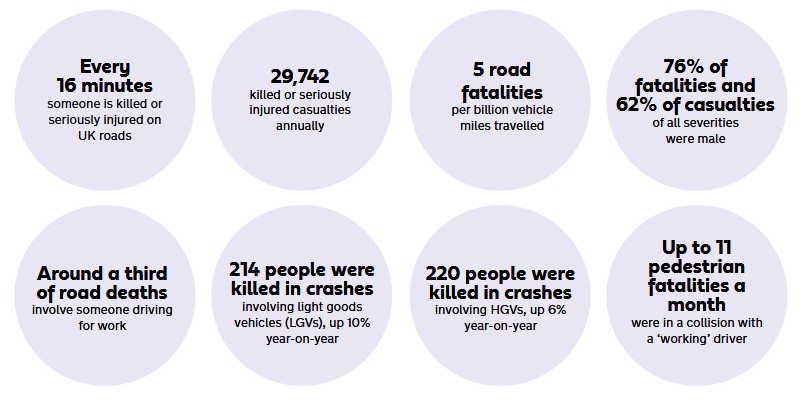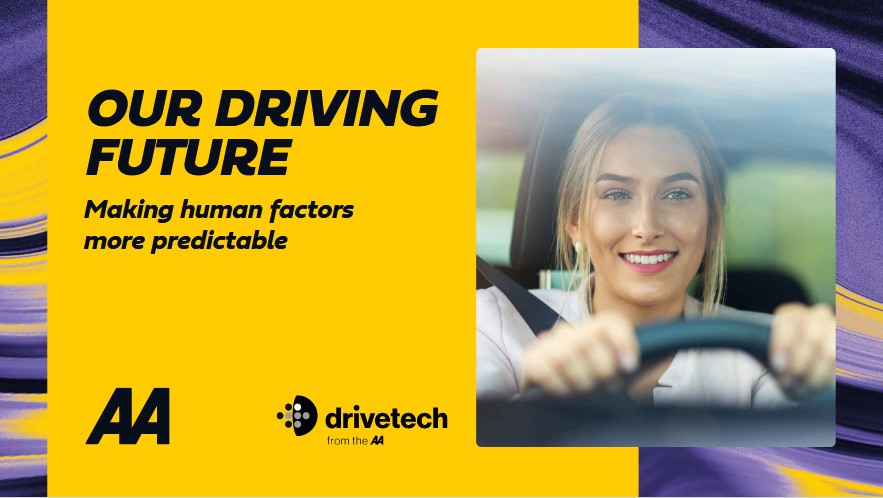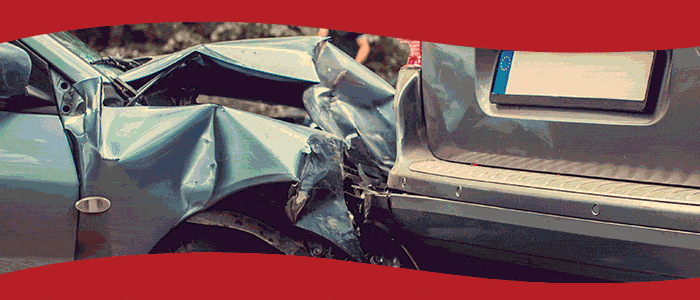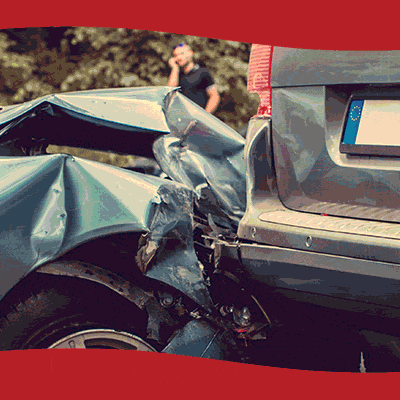FOREWORD: Driving is changing. Technology, regulation and infrastructure are evolving rapidly, and this will impact our future mobility. No matter how good the technology, the safety of drivers, passengers, all other road users, and pedestrians is paramount. We shouldn’t be at all complacent about road fatalities, as every death or injury is preventable. This is why we’ve written this paper. When we consider fleet risk, there are three key areas: people, infrastructure, and vehicles. Here, we’re shining the spotlight on the risks around people and how these can be managed.
As humans we’re complex beings and, while technology may be evolving at pace to increase our safety behind the wheel, the greatest factor that determines the risk of a collision is human behaviour. According to the World Health Organization (WHO), around 1.19 million people die each year as a result of road traffic incidents. This is estimated to be the eighth leading cause of death across all age groups globally – and this is set to rise. Tragically it is also the leading cause of death amongst the younger age group. Overall road traffic incidents are predicted to become the seventh leading cause of death by 2030.
In the UK, someone is killed or seriously injured on UK roads every 16 minutes (Department for Transport). We cannot allow this to continue. For businesses, driving can be one of the most dangerous activities that your employees will do. Around a third of road deaths involve someone driving for work (UCL and Agilysis).
So, to make a truly positive difference to road safety and fulfil our legal duty of care as employers, it’s time to elevate the importance of human factors and driving. In an environment of rapid change, our drivers are likely to need more support than ever. We need to think beyond just practical steps, such as licence checking and incident reporting, and really explore what it means to be ‘fit to drive’.
Advertisement
It’s time to firmly turn our attention to the human factors that impact driving and what these mean as we move towards a new world of mobility, with advancing technology and fundamental changes to how we use vehicles. It’s an incredibly exciting period of change, with huge opportunities for improvement that will make transport safer, more sustainable, and efficient.
At The AA, our aim is to create confidence for drivers, making sure they have the right help and support they need at every stage of their driving lives. This is why we recently launched our motoring manifesto, ‘Creating Confidence for Drivers’. A key part of this is safety on the roads. We believe road death needs to be higher on the political agenda and there needs to be a dedicated multi-agency approach to tackle the issue. Our hope is that this manifesto helps shape a better road ahead for all drivers. So, let’s work together to make safer roads a reality.
Edmund King OBE AA President
What are human factors?
There are a huge number of variables involved in the act of driving, such as traffic, weather, vehicle, and road condition and these are constantly evolving. But the most significant is the human.
Humans are complex, with changing physical and mental needs that impact our behaviour. Then, as we’ve all experienced, driving too, is a complex task.
Driving requires a combination of visual, manual, and cognitive skills. And how we perform behind the wheel can be very different whether we’re senior, young, speeding, stressed, distracted, under the influence of drugs or alcohol, unwell and many more factors. It’s no surprise then, that human error is a component in 95% of all road incidents (RoSPA). The increased use of data and AI is giving us more insight than ever before to help us understand driver behaviours and their role in safety. We can use this insight to improve the statistics and saves lives. So, what’s the data telling us?
The current road safety picture
 Department for Transport. Reported road casualties Great Britain, annual report: 2022
Department for Transport. Reported road casualties Great Britain, annual report: 2022
Driving for work – a strategic review of risks associated with cars and light vans, implications for policy and practice

Remember, driver training isn’t a one-off tick-box exercise. It’s vital to maintain a training programme that continues to reinforce what’s been learnt and refresh skills as regulations, infrastructure, and vehicle technologies evolve. A great way to do this is using short videos, such as Drivetech’s EV Co-Driver, a series of simple to digest clips designed to help fleets and their drivers transition to EVs. These can be watched from most devices to help drivers with best practice handling tips for EVs. Don’t overlook the importance of regular driver education. This doesn’t just apply to when there’s a change in vehicle technology, an addition to The Highway Code, or updated legislation; it’s also an important reminder for drivers not to use mobile phones, how best to minimize driver distraction in the vehicle, when to take driving breaks, and how to identify if you are well enough to drive.
Prioritising wellbeing for improved driver safety
When it comes to the impact of human factors on driver safety, understanding the role of wellbeing is paramount.
Advertisement
When we talk about wellbeing, we’re referring to physical, mental, emotional, and social health. Each element of a driver’s health, both physical and mental, profoundly influences their ability to operate vehicles safely. Put simply, drivers experiencing stress, fatigue, or poor physical health are more prone to errors, distractions, and impaired decision-making while driving.
Factors like inadequate sleep, unhealthy lifestyle habits, and chronic medical conditions can compromise a driver’s alertness and reaction times, increasing the risk of incidents and injuries. It’s estimated that fatigue is a factor in up to 20% of all road traffic collisions (Department for Transport).
And a study by Warwick University found that at any one time, 20% of people in the developed world are suffering from sleep problems.
While wellbeing is critical to all employees, it can be particularly relevant to those who drive as part of their job. Driving is unpredictable, with a range of pressures that are outside of a driver’s control, such as traffic and delivery deadlines that can easily disrupt the working day. The nature of the role can also mean physical health is compromised if not prioritised. For example, drivers spend a long time sitting down, so exercise might be limited, and it can be easy to rely on fast food. Furthermore, driving, especially for long distances, can be lonely and loneliness is a top cause of mental health issues.
What businesses can do to prioritise wellbeing
First and foremost, it’s important to ensure wellbeing is a priority company wide. Establish a wellbeing strategy, set out goals for what you want to achieve and then regularly review and monitor the programme. Knowledge is power, so collect data you can analyse and use this to adapt your strategy accordingly to maximise its success.
Wellbeing needs to be embedded in the culture of a business. This is a culture that priorities health, safety, and work-life balance. What’s included in the wellbeing strategy and what programmes are put in place will need to be different for each business, unique to its structure and the needs of its employees and drivers. It may include health screenings, access to counselling, workshops and more.
As part of a culture that supports wellbeing, businesses should create supportive work environments that prioritise open communication, employee engagement, and social connectivity among drivers. Encouraging peer support networks, establishing mentorship programs, and fostering a sense of belonging can enhance drivers’ sense of wellbeing and job satisfaction.
Finally, don’t overlook the importance of direct engagement with employees. Get close to drivers and find out what’s impacting them and what matters to them most. For example, if they’re delivery drivers, does traffic and scheduling put them under pressure? If drivers are doing long distances, are they managing fatigue and potential loneliness? This can be done through regular employee surveys and interviews, alongside planned line manager reviews. This will also enable routes to measure and monitor the effectiveness of a wellbeing programme.
Advertisement



























